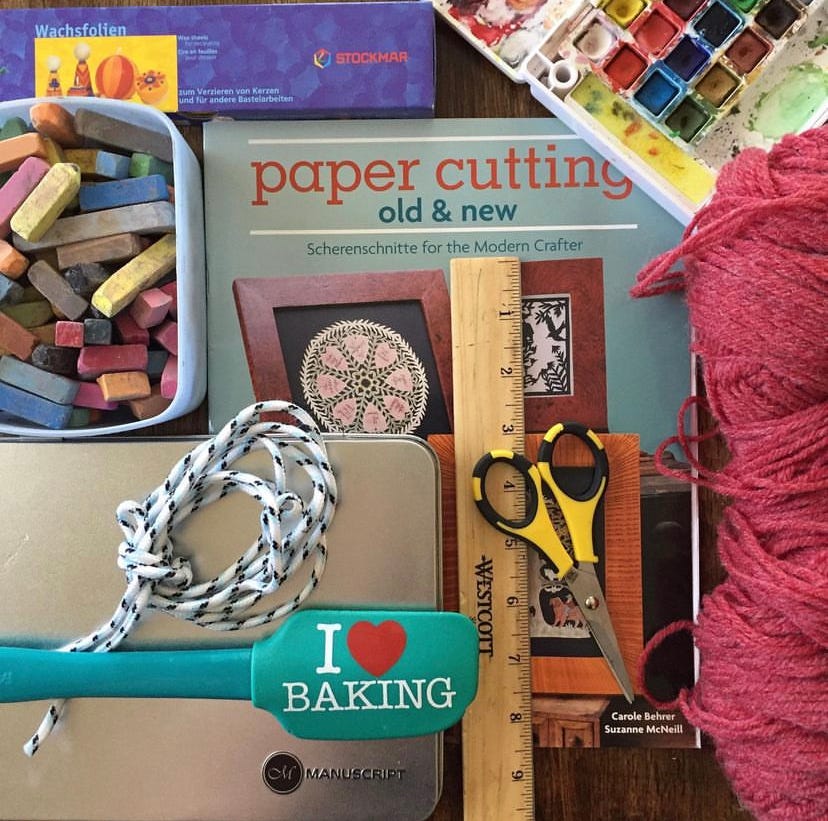At Ms. Mason’s House of Education, the ideal held in esteem was “plain living and high thinking.” Hers was not an attempt at a detached, intellectual life but a hearty view of mind and body, trained, balanced, and working together in harmony.
We see the effect of this perspective in many aspects of the curriculum she created, and in no place does it shine forth with as much clarity as in the recommendation of regularly setting time aside for Handicrafts. The education she envisioned trained the mind and the hands and ingeniously valued and integrated the two. Had not the goal of self – but a goal of being of use to others. There was an outward focus in her person and in her hopes for her students.
Handicraft particulars run the gamut from basket weaving and bookbinding to whittling and needlework. While there is a quaintness to her lists from our perspective, we must keep in mind the necessity of these skills in her time; this will shield us from an “Arts & Crafts” assumption and direct us to deeper motives and higher goals.
Three stand out.
One is that the training of dexterity and ability in any type of handwork is good preparation for that skill and any other that comes along. Nimble fingers, precise movements, sharp eyes, and understanding of spaces are helpful in all areas – let’s provide the opportunity for that.
The second goal was to equip the students to have something tangible to offer the people around them. This is an important need for all people. It is crucial as children begin to step into their communities as individuals in their own right. The desire to contribute can be seen in the youngest toddler – the ability to contribute something genuinely meaningful is pivotal to many aspects of emotional and physical well-being. This is something their education should provide for. Too often, what we ask of our children can make them feel they are the goal. This is dangerous in its curious ability to puff up and crush. What if our training – even from the earliest ages - was for reaching beyond self?
Finally, in the emphasis on handicrafts as an integral part of the schedule and not just a fun extra, we see the cohesiveness of Ms. Mason’s method. Just as she viewed knowledge as a unified whole, discarding the secular/ sacred dichotomy long before it was trendy to do so, so also did she view the human being as a whole, the mind (intangible), and the body (tangible) as one being working towards the same ends.
Morning lessons are not something separate for the mind, and afternoon occupations something separate for the body, but rather the two are linked. Ideas from morning lessons need time and space to germinate and take root; the practice of handicrafts consistently can carve out conducive space. In the beginning, acquiring a handicraft skill is all-consuming, but with consistency comes mastery, or at the very least, habit. The repetition and rhythm of productive activity can form a sort of “white noise” for thinking and rumination. Most children are not content to sit passively without their hands engaged in something! In Ms. Mason's scheme, the hands are busy – allowing the mind to be free. And often more than free –vitalized!
When considered in this light, we see that Ms. Mason’s prescription for handicrafts is more than relevant today. With this close inspection, we even glimpse a more nuanced purpose than first suspected. We also see permission to add to the list in our time. What are the needs to be met today? What might be offered to others as useful? How can we develop productive “white noise”?
As we borrow from and tweak Ms. Mason's original lists, keep in mind that, in some ways, our lists will look similar to each other – but in other ways, they will look differently. You have different people and different needs around you. The fundamental thing is that the child perceives usefulness to the task that they are put to. Let there be a connection of why and/ or to whom. Let there be purpose and value.
Handicrafts remind us that education is not just about the mind but also the hands; that these two are parts of a greater whole. It allows us to communicate that education is not just about me, but others also.
Sara Timothy 2023
For Further Reading in the Volumes:
Home Education, p. 315-16
A Philosophy of Education, p. 328
For Further Learning:
Handicrafts - AmblesideOnline - Charlotte Mason Curriculum
What Hands Are For (charlottemasonpoetry.org)
Handicrafts and Life Skills - Simply Charlotte Mason
100 Handicrafts for the Early Years - My Little Robins
Charlotte Mason Series #8 – Handicrafts and Life Skills - Our Journey Westward
Humanity Unfolds Itself: Handcrafts and the Boy • Sage Parnassus
HANDICRAFTS | Charlotte Mason Help
The Non-crafty Mom's Guide to Handicrafts - Afterthoughts (afterthoughtsblog.net)
Handicrafts as Knowledge of the Universe - Afterthoughts (afterthoughtsblog.net)
Resources:
Handicrafts - Charlotte Mason Institute
Editor’s Corner Picks (These are extra items we use in our own homes):
Creative Woodburning: Projects, Patterns and Instruction to Get Crafty with Pyrography
Paper Sloyd: A Handbook for Primary Grades
30-Minute Drawing for Beginners
Bradove 4 Set Embroidery Stitches Practice Kit
The Complete Cookbook for Young Chefs
www.ravelry.com-for knitting and crocheting ideas!



